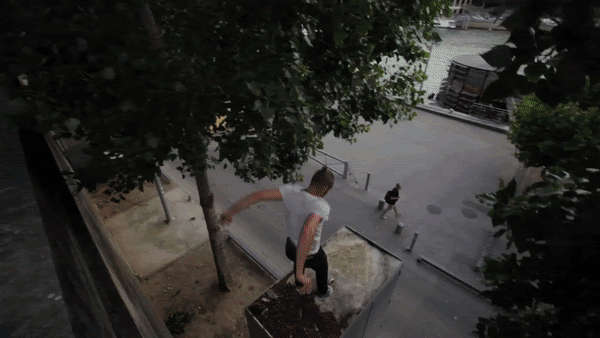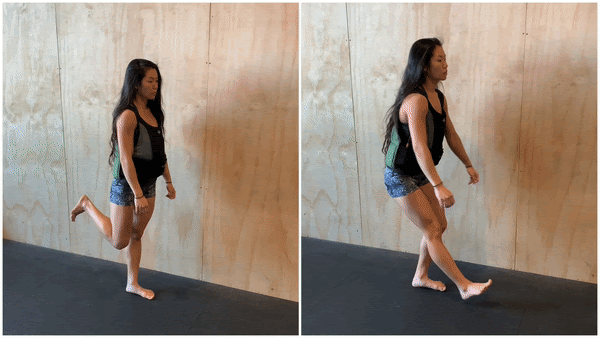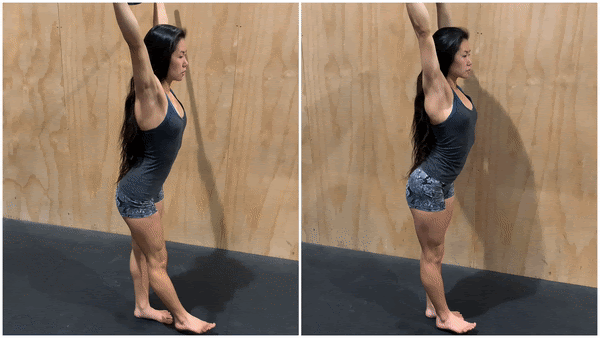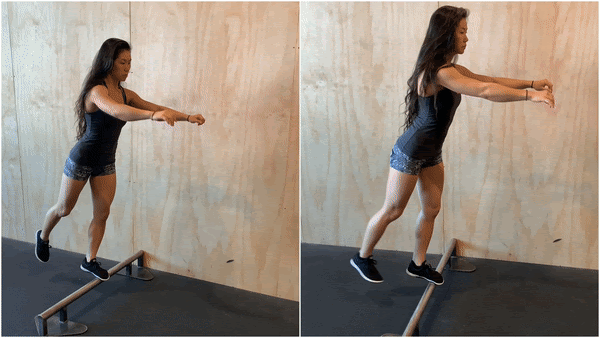Shrimps, pistols, and other single-leg squat variations are not for strength and power. There are better ways to get truly strong and bouncy (e.g. deadlift, back squat, split squat, power clean, sprint, jump/land, etc). But with greater levels of power come higher amounts of impact. To be truly high-performing and long-lasting in high-impact sports, you must survive this impact time and time again. All of your squatting/landing/falling skills need to be on point.
To further complicate some of these key skills, a certain amount of mobility is required in order to do them well (e.g. spinal flexion in rolling, full squat mobility in max jump/land height & distance). Many people lack mobility (active flexibility) in one or more of their joints, which also limits their strength and skill in key athletic positions (e.g. full squat, deep ankle dorsiflexion, pike).
I’m always looking for the most simple and effective ways to build a more long-lasting lower body (especially when it also boosts jump/sprint performance). When it comes to upgrading your leg armor, I often recommend shrimps/pistols as one main strategy. In my experience working with a diverse amount of athletes, shrimp/pistol training helps pretty much across the board. You don’t need to be great at all the shrimp/pistol movements but you should strive for incremental improvements over many months and years.
Do you have a few minutes throughout your day to work on a shrimp/pistol progression? All you need is flat ground and a basic understanding of shrimp/pistol mechanics and progressions.
If you lack the range of motion (ROM) needed to enter and exit optimal positioning for jumping, landing, and sprinting, you’re missing out on untapped potential. When it comes to mobility and more robust joints, I didn’t realize what I was missing until it was too late. The best time to address this stuff is when you’re a kid or a teen. The second best time to start is now.
Limited ankle dorsiflexion contributed to my poor squatting and landing mechanics, leading me to preventable injuries and surgeries for chondromalacia patellae in my left knee and anterior ankle impingement syndrome in my right ankle. If I maintained or acquired better ankle dorsiflexion and full squat mobility as a teen, I’m confident that I would’ve avoided serious setbacks and become a far better athlete into my twenties and beyond.
If I could go back and do it over, I’d lean heavily on shrimps/pistols to help improve my stiff ankles and subpar full squat. Over the past few years, shrimps/pistols have helped rebuild my own ankles and knees (along with walking and weightlifting), allowing me to overcome surgeries and get back to full speed. Here are some main reasons why athletes should consider adding shrimps/pistols to their routines:
Mobility & joint prep
At Apex School of Movement, we rarely use shrimps/pistols for developing general leg strength but we *love* them for mobility training. These single-leg squats are simple, effective ways to develop resiliency in your deepest/weakest end ROMs.
For example, many people with “strong” legs also have a crackly, wobbly full squat due to a lack of mobility, too much sitting, bad footwear, etc. Despite decent leg strength from years of lifting, having a stiff full squat may hold you back in sports that involve frequent squatting/landing/falling. On the other hand, someone with exceptional full squat strength *and* mobility is more adept when moving through deep, unexpected ROMs.
We are weakest in our end ROM. Impact-related injuries from landing/falling often involve hitting end ROM in your toes, feet, ankles, knees, and/or hips. The more strength you have in your end ROM, the more potential you have to safely absorb landing/falling forces. Two simple equations to keep in mind (load means landing/falling forces, capacity refers to your own strength):
load > capacity = injury 🤕
load < capacity = all good 👍
In the quest for more capacity to overcome more load, shrimps/pistols are key for testing/building/retesting better lower body mobility and mechanics. If controlling the bottom position of shrimps/pistols is difficult due to tight ankles, weak legs, or poor balance, consider working toward these single-leg squats as way to improve performance and mitigate risk of injury. Shrimps/pistols improve landing quality and lessen the likelihood of injury from falls. More ankle dorsiflexion and squat/pike mobility can even help you reach your feet for further/higher on big jumps.
View this post on InstagramA post shared by Joey Bergles (@joeybergles) on
Landing/falling defense
Better shrimps/pistols are a complement to, not a replacement for, competent falling skills. There are physical, technical, and mental factors to consider for every bail. To level up your falling tech, check out Art of Falling by Amos Rendao and his Parkour Ukemi YouTube channel (source of the GIFs below) 👀
In addition to clean falling skills, strong/mobile legs are key to reducing impact-related injuries. Sometimes in training, we unexpectedly end up in imperfect, improper positions (shout-out Dr. Verkhoshansky for the concept of imperfection training).
Here’s a common one from parkour. Imagine you’re jumping to a handrail and due to a slight miscalculation, one foot slips out upon impact––either behind you (shrimp-style) or in front of you (pistol-style). Now your other leg is suddenly taking more impact than expected. Maybe too much impact. Maybe in a weak, unfamiliar position. Then what?
- Worst-case scenario (load > capacity = injury): the shrimp/pistol slip-out is too much force and you feel a painful pop or crunch––maybe an ankle sprain, broken leg, or another acute injury. It might also feel ok after a few minutes (or days) but act as just another small step toward chronic injuries like jumper’s knee, runner’s knee, or shin splints. You don’t notice yet, but you will.
- Best-case scenario (load < capacity = all good): you get lucky on the shrimp/pistol slip-out, bounce right up, and laugh it off. Or maybe you’re fine partly because you prepped your mobility, strength, and landing/falling skills to safely handle impact in an imperfect/improper or end-range position.
🦐 Shrimp slip

View this post on InstagramI don’t fail much but when I do it’s spectacular 😂😂😂 – – – Thanks @domtomato for filming 🖤🖤
A post shared by Michael Khedoori | Parkour (@khedoori) on
🔫 Pistol slip

View this post on InstagramA post shared by Stefy Navarro🇨🇴 (@stefymadness) on
By expanding and strengthening our end ROM (physical tools), shrimps/pistols help us decrease the odds of injury. Good falling skills (technical) further decrease the odds, as do sharp/confident mindsets (mental).
The longer and more intensely you train parkour, the more slips and falls you’ll accumulate. Mistakes are inevitable and we are not indestructible. Parkour is high-impact, and accumulation of impact will eventually punish crappy mechanics and mobility. Just a few minutes of shrimp/pistol prehab every day might be annoying and boring, but it’s better than sitting out 4-6 weeks (or months) due to injury!
🦐 Shrimp squat
Shrimp squats are less famous than the pistol but they are just as useful for building leg strength, active ankle dorsiflexion, and hip flexor mobility. For this single-leg squat variation, lift one leg off the ground by flexing your heel to your butt. As you squat down with your foot flat on the ground, lightly touch your knee to the ground before pushing back up to stand. Work to keep your chest upright instead of slouching forward, and aim to keep the non-working femur (upper leg) perpendicular to the ground.
To increase the strength and mobility demands, grab your non-working foot with the same hand and perform the exercise. For the next harder progression, use both hands to hold the non-working foot. For the full jumbo challenge (see harder progressions below), try a shrimp squat on a box or bench, squatting your knee below the surface you’re on. Remember that a greater ROM demands increased lower body mobility and strength.
🔫 Pistol squat
Pistol squats are a challenging single-leg squat classic in which you hold a leg straight in front of you while lowering down on the other. The goal is to build better squat *and* pike mobility by keeping your front leg hovering above the floor as you squat as low as possible.
Staying balanced while you keep your foot flat on the floor takes strength, skill, and significant ankle mobility. You’re doing great if you can keep your front leg fully locked out during the movement. You’re a beast if you can grab the straightened leg with one or both hands throughout the full movement.
🦐 🔫 Shrimp/pistol squat progressions & variations
Heel-elevated shrimp/pistol (easier)
- Poor ankle dorsiflexion (foot to shin) is one main reason why people struggle with shrimps/pistols.
- Elevating the heel is an effective way for people with poor ankle dorsiflexion to practice with better form and improve mobility.
- Use the minimum amount of heel-elevation needed to do each rep flat-footed, it should challenge your active ankle mobility.
- Develop mobility by gradually relying on less heel-elevation, until you can do it flat-footed on flat ground.
- Significant mobility gains can take months to notice and lock in, you have no choice but to be consistent and work hard.
Assisted shrimp/pistol (easier)
- Another main reason people can’t do shrimps/pistols is that they aren’t strong or skilled enough.
- Grabbing an obstacle nearby for assistance is a simple and effective way to get better.
- Use the least amount of arm strength as possible, it should be a challenge for your legs.
- Develop more strength, balance, and control by gradually relying less on arm + obstacle assistance.
- Strength/skill-related gains on shrimps/pistols only take weeks (much quicker than mobility gains).
Box pistol + elevated pistol (easier)
- The box pistol (left) is a progression for people who lack ankle dorsiflexion, squat mobility, and/or strength to do pistols with full ROM.
- The elevated pistol (right) is a progression for people who lack the pike mobility needed to do a pistol on flat ground with their free leg straight and off the ground.
- Both progressions allow people to build mobility and strength in positions that they can’t normally access.
- For elevated pistols, use the shortest box in which you can do a full rep with your free leg straight and off the ground.
- For box pistols, use the shortest box in which you can do a full rep with a flat foot and minimal forward/backward rocking momentum.
Jumbo shrimp (harder)

- One main problem with shrimp squats is that the ground limits ROM.
- To keep developing higher levels of mobility, do jumbo shrimps on gradually taller obstacles. While learning to control deeper ROM, feel free to check down to shrimps with 1 or 2 less hand grabs.
- Try flat-footed variations for ankle mobility work, ball-of-foot variations for quad strength work.
- If you can bang out quality jumbo shrimps, you probably don’t need to work them often––just occasionally for maintenance.
Dragon pistol (harder)
- For athletes who can easily rep normal pistols with good form, the dragon pistol offers an extra challenge for pike/squat mobility.
- Although dragon pistols are a less common shape during falling, some twisting acrobatics movements could send you into a similar position.
- The hand-grab variation requires more passive ROM while the no-grab variation requires more active pike/squat mobility and strength.
- If you can’t yet do a dragon pistol on flat ground, try it on an elevated obstacle (shown earlier in this post) to slightly reduce the pike/squat mobility requirement.
- If you can bang out quality dragon pistols, you probably don’t need to work them often––just occasionally for maintenance.
Weight vest shrimp/pistol (harder)

- One of the easiest/simplest ways to add load for extra strength/mobility gains.
- Good weight vests are expensive but a good training investment if you have disposable income.
- Cheap weight vests may fall apart quickly or make it hard to add/subtract small amounts of weight.
- Weight vests help spread the weight evenly throughout your upper body, making it more “natural” / sport-specific than other methods used to load shrimps/pistols.
- If you don’t have a weight vest, try adding weight with goblet or overhead shrimps/pistols.
Goblet shrimp/pistol (harder)
- This shrimp/pistol variation requires more strength, but also less ankle/squat mobility.
- Holding the weight farther out in front of you creates a counterbalance that requires less ankle mobility.
- Keeping the weight as close to your body as possible will make shrimps/pistols more challenging.
- If you have access to many different dumbbells, gradually work up to moving more weight over time.
- Advanced athletes can experiment with heavy shrimp/pistol negatives (eccentrics), drop the weight at the bottom, and explode back up (unloaded).
Overhead pistol (harder)

- If you have good full-body mobility and want an efficient way to challenge many joints at once, hold weight in the overhead position.
- There are many creative ways to add load to overhead shrimps/pistols via bumper plates, dumbbells, sticks + plates, etc.
- Most people lack the full-body mobility to do this movement and will struggle to keep the weight centered and overhead.
- If you can’t do this movement with good form, try weight vest or goblet shrimps/pistols instead.
- Again, this movement is ridiculously hard to do well but if you can, it’ll help take your full body mobility gains to the next level.
Balance x shrimp/pistol
Shrimps/pistols don’t always have to be boring, flat-ground movements done primarily for mobility or end range strength. Try mixing in some balance to keep things fun and challenging.
Side balance shrimp/pistol
- Side balance shrimps/pistols add more difficulty due to their huge demand for balance and stabilization.
- These variations build control and confidence on rails, plus they’re a slightly easier progression to try before front balance variations.
- Avoid side-to-side foot/leg wobbles in order to improve stabilization skills for stronger footwork and less force leaks during strides, tacs, etc.
- Strive to do all the work with legs by limiting upper body balance checks as much as possible.
- For advanced athletes, side balance shrimps allow for extra ROM similar to the jumbo shrimp variation.
Front balance shrimp/pistol

- Front balance shrimps/pistols add an extra layer of difficulty due to their huge demand for balance and stabilization.
- These variations simulate the strength, skill, and mobility you need to safely bail out of single-leg slips.
- Front balance shrimps mimic single-leg slips behind the rail while front balance pistols prep you for single-leg slips to the front.
- Because front balance shrimps/pistols are done on the ball-of-foot, they help target the VMO muscle (part of your quads) which is important for side-to-side knee stabilization.
- For advanced athletes, front balance shrimps allow for extra ROM similar to the jumbo shrimp variation.
Jump/land x shrimp/pistol
Once you’ve explored shrimps/pistols mixed with balancing skills, try branching out into jumping/landing next. After you get comfy with the drills below, you can even try simulating slip-out falls in which you jump, land precisely, absorb/control into a shrimp/pistol position, and then into the appropriate falling skill from there. It won’t be 100% realistic, but it will help prep you for the next time a shrimp/pistol slip-out occurs.
Broad jump → shrimp landing
- When it’s easy to stick/stabilize 2-foot landings, it’s time for more single-leg training.
- Broad jump to shrimp landings are effective ways to lower your average time to stabilization (the amount of time it takes to stick/stabilize upon impact).
- Lower times to stabilization mean better control and positioning, often resulting in stronger footwork and less force leaks during strides, tacs, etc.
- Better shrimps = better single-leg jump/land skills (notice the shrimp position during each landing).
- Start with jump distances and heights around 25-50% of your max. When you have consistent/fast stick landings, gradually progress toward max power.
Lateral jump → shrimp landing
Box jump → shrimp landing
1 leg box jump → shrimp landing
Kong-up → shrimp landing
Top-out → shrimp landing
Broad jump to single-leg precision landing

- When it’s easy to stick/stabilize BJSLL drills on flat ground and big targets, try it on precise targets.
- Lower times to stabilization mean better control and positioning, often resulting in stronger footwork and fewer force leaks during strides, tacs, etc.
- Better shrimps = better single-leg jump/land skills (notice the shrimp position during each landing).
- Start with jump distances and heights around 25-50% of your max and when you have a consistent stick/stable landing, gradually progress toward max power.
- Because these jump/land drills are done on the ball-of-foot, they help target the VMO muscle (part of your quads) which is important for side-to-side knee stabilization.
Learn more
For more on developing your shrimp squat, pistol squat, and more, check out this free playlist on my YouTube, my book on Amazon, or if you’re interested in personalized remote training/programming, learn more + apply here 🙂

Thanks Ryan et al for this great post. Would you address the common warning about not moving your knee passed your toes as you squat. I recognize with skill acquisition, masters know how to “break the rules” and I’m interested in your take on this. Maybe I don’t have a good angle on it, but in most of the GIFs involving demonstration, the athlete’s knees are going beyond her toes.
If this is a matter of strength (or maybe it’s really knee mobility?), then I assume it’s a matter of slowly progressing to that point, but I’m still interested in expert advice.
knees past toes happens all the time in athletics and even in real life. it’s no big deal, especially when developed with mindful attention to mechanics.
you often need knees past toes to access the full potential of your ankle dorsiflexion, a key position during take-offs, landings, sprints, squats, etc. if we need to develop greater/stronger ankle dorsiflexion for improved performance and/or fewer injuries, fully loading the knee past toes with a flat foot is one of the best ways.
Excellent article!!
thanks for reading!